updated 2016-06-21
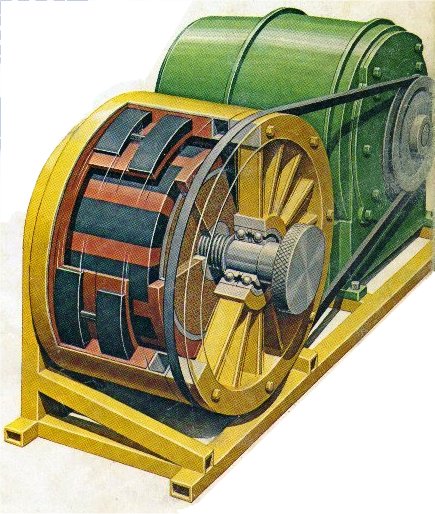
United States Patent
4,151,431
Johnson; Howard R.
3300 Mt. Hope Rd.,
Grass Lake, MI 49240
Filed: December 6, 1973
“Preferably, a plurality of armature magnets are used which are staggered with respect to each other in the direction of armature magnet movement. Such an offsetting or staggering of the armature magnets distributes the impulses of force imposed upon the armature magnets and results in a smoother application of forces to the armature magnet producing a smoother and more uniform movement of the armature component.”
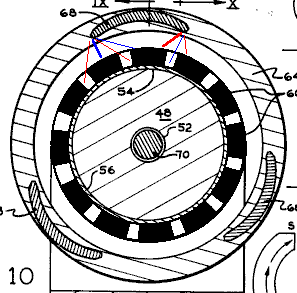
this drawing is not part of the patent submission.
“In the rotary embodiment of the permanent magnet motor of the invention the stator magnets are arranged in a circle, and the armature magnets rotate about the stator magnets. Means are disclosed for producing relative axial displacement between the stator and armature magnets to adjust the axial alignment thereof, and thereby regulate the magnitude of the magnetic forces being imposed upon the armature magnets. In this manner the speed of rotation of the rotary embodiment may be regulated.”
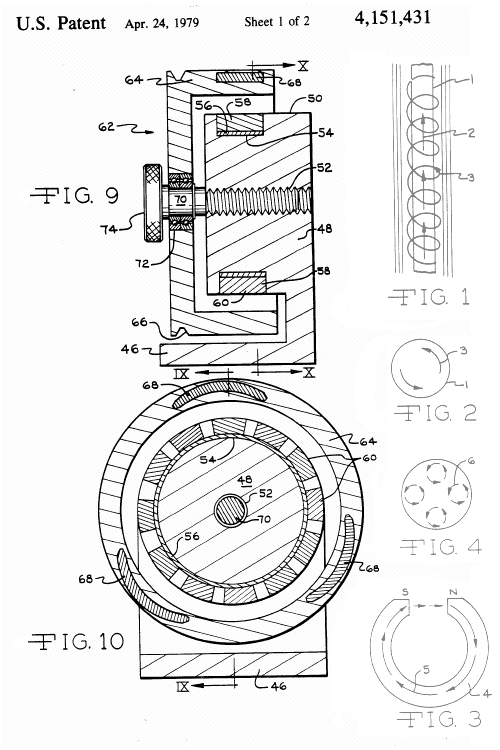
“pay no attention to the ferrite graph (fig 1-4),
it belongs in some other patent!” -HJ *
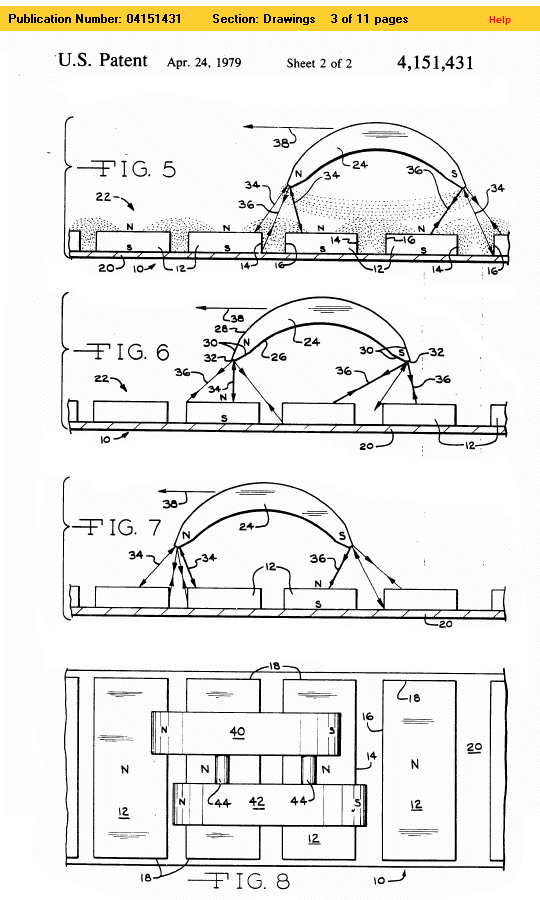
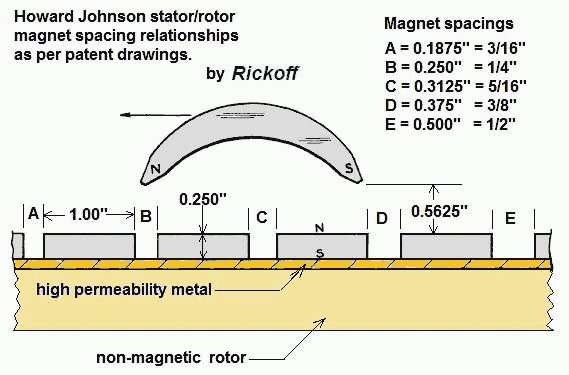
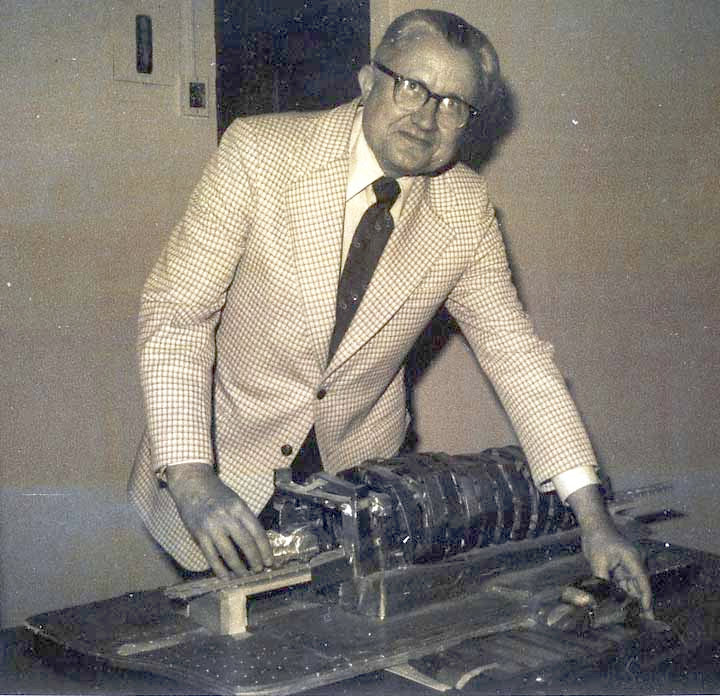
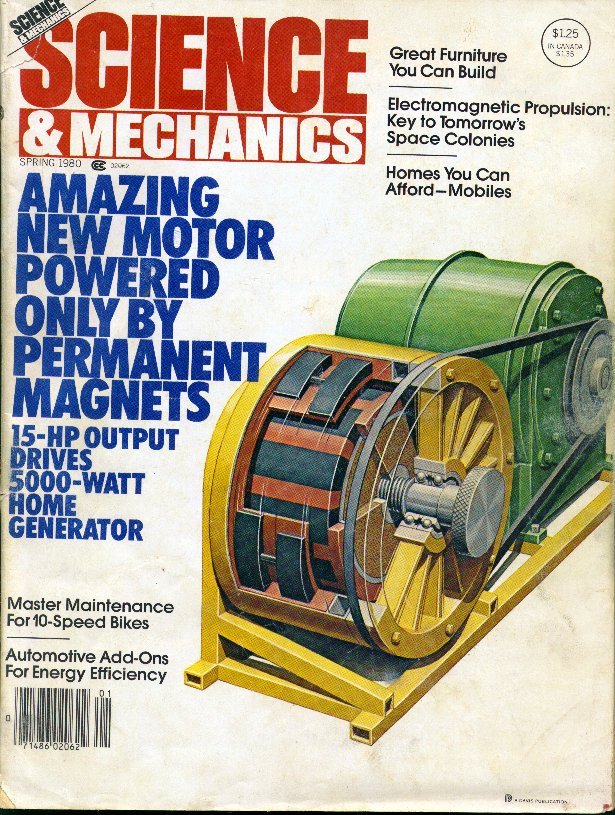
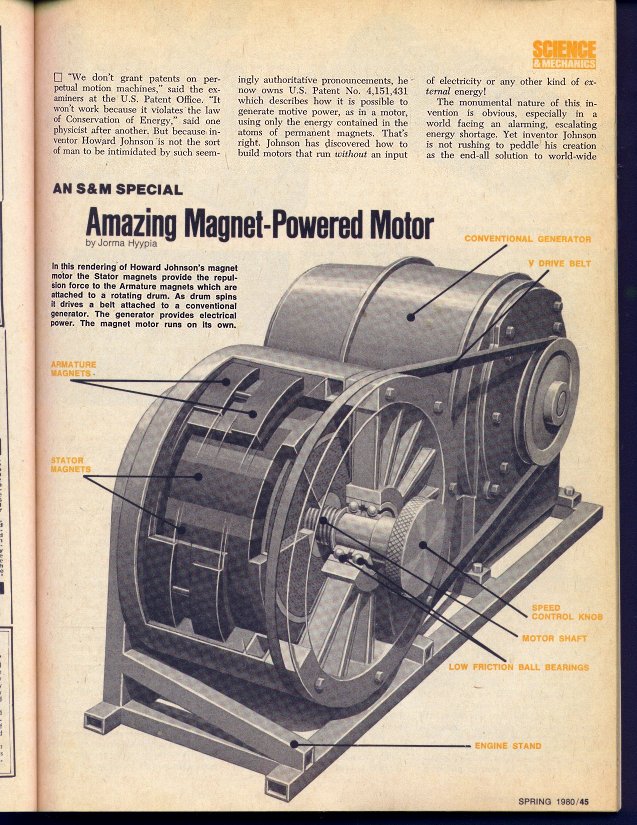
Science & Mechanics (Spring 1980)
AN S&M SPECIAL
“Amazing Magnet-Powered Motor”
by Jorma Hyypia
“We don’t grant patents on perpetual motion machines,” said the examiners at the U.S. Patent Office. “It won’t work because it violates the law of Conservation of Energy,” said one physicist after another. But because, inventor Howard Johnson is not the sort of man to be intimidated by such seemingly authoritative pronouncements, he now owns U.S. Patent No. 4,151,431 which describes how it is possible to generate motive power, as in a motor, using only the energy contained in the atoms of permanent magnets. That’s right. Johnson has discovered how to build motors that run without an input of electricity or any other kind of external energy!
The monumental nature of the invention is obvious, especially in a world facing an alarming, escalating energy shortage. Yet inventor Johnson is not rushing to peddle his creation as the end-all solution to world-wide energy problems.
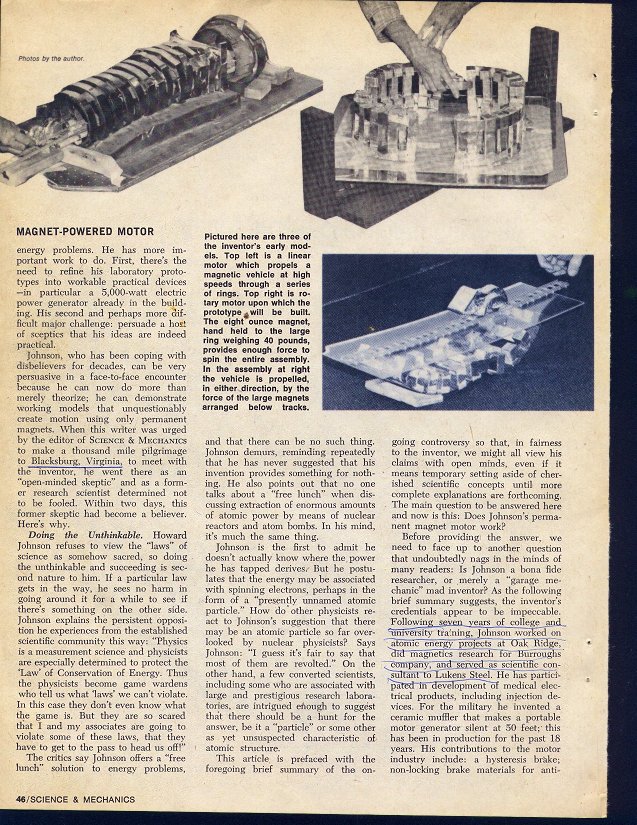
He has more important work to do. First, there’s the need to refine his laboratory prototypes into workable practical devices -in particular a 5,000-watt electric power generator already in the building. His second and perhaps more difficult major challenge: persuade a host of skeptics that his ideas are indeed practical.
Johnson, who has been coping with disbelievers for decades, can be very persuasive in a face-to-face encounter because he can do more than merely theorize; he can demonstrate working models that unquestionably create motion using only permanent magnets. When this writer was urged by the editor of Science & Mechanics to make a thousand mile pilgrimage to Blacksburg, Virginia, to meet with the inventor, he went there as an “open-minded skeptic” and as a former research Scientist determined not to be fooled. Within two days, this former skeptic had become a believer. Here’s why.
Doing the Unthinkable 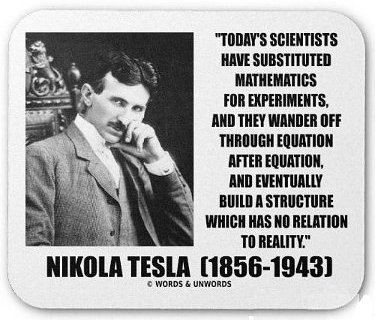
Howard Johnson refuses to view the “laws” of science as somehow sacred, so doing the unthinkable and succeeding is second nature to him. If a particular law gets in the way, he sees no harm in going around it for a while to see if there’s something on the other side. Johnson explains the persistent opposition he experiences from the established scientific community this way: “Physics is a measurement science and physicists are especially determined to protect the Law of Conservation of Energy. Thus the physicists become game wardens who tell us what laws we can’t violate. In this case they don’t even know what the game is. But they are so scared that I and my associates are going to violate some of these laws, that they have to get to the pass to head us off!”
The critics say Johnson offers a “free lunch” solution to energy problems, and that there can be no such thing. Johnson demurs, reminding repeatedly that he has never suggested that his invention provides something for nothing. He also points gut that no one talks about a “free lunch” when discussing extraction of enormous amounts of atomic power by means of nuclear reactors and atom bombs. In his mind, it’s much the same thing.
Johnson is the first to admit he doesn’t actually know where the power be has tapped derives. But he postulates that the energy may be associated with spinning electrons, perhaps in the form of a “presently unnamed atomic particle.” How do other physicists react to Johnson’s suggestion that there may be an atomic particle so far overlooked by nuclear physicists? Says Johnson: “I guess it’s fair to say that most of them are revolted.” On the other hand, a few converted scientists, including some who are associated with large and prestigious research laboratories, are intrigued enough to suggest that there should be a hunt for the answer, be it a “particle” or some other as yet unsuspected characteristic of atomic structure.
This article is prefaced with the foregoing brief summary of the ongoing controversy so that, in fairness to the inventor, we might all view his claims with open minds, even if it means temporary setting aside of cherished scientific concepts until more complete explanations are forthcoming. The main question to be answered here and now is this: Does Johnson permanent magnet motor work?
Before providing the answer, we need to face up to another question that undoubtedly nags in the minds of many readers: Is Johnson a bona fide researcher, or merely a “garage mechanic” mad inventor? As the following brief summary suggests, the inventor’s credentials appear to be impeccable. Following seven years of college and university training, Johnson worked on atomic energy projects at Oak Ridge, did magnetics research for Burroughs company, and served as scientific consultant to Lukens Steel. He has participated in the development of medical electrical products, including injection devices. For the military he invented a ceramic muffler that makes a portable motor generator silent at 50 feet; this has been in production for the past 18 years. His contributions to the motor industry include: a hysteresis brake; non-locking brake materials for anti-skid application,

new methods of curing brake linings; and a method of dissolving asbestos fibers. He has also worked on silencers for small motors, a super charger, and has perfected a 92-pole no-brush generator to go in the wheel of Lincoln automobiles as a skid control; that last item reduced the cost to one-eighth of the cost of an earlier design by utilizing metal-filled plastics for the armature and field. In all, Johnson is connected with more than 30 patents in the fields of chemistry and physics.
Sticky Tape Scientist
Despite his impressive credentials, this amiable and unpretentious inventor likes to characterize himself as a “Sticky tape” scientist. He sees no virtue in wasting time building fancy, elaborate equipment when more simple assemblies serve as well to test new ideas. The prototype devices shown in the photographs in this article were assembled with sticky tape and aluminum foil, the later material being used mainly to keep individual, permanent magnets packaged together so that they do not fly apart.
Perhaps the best way to describe what these three gadgets do is by reciting this writer’s personal experiences during the interview demonstration. That way I will not merely be telling what the inventor says they do, but I will reveal what happened when I tried the experiments myself. When we start talking about how and why the things work as they do, well have to rely on the inventor’s explanations.
The first item consists of more than a dozen foil-wrapped magnets assembled to form a broad arc. Each magnet is extended upward slightly at each end to form a low U-shape, the better to concentrate magnetic fields where they are needed. The overall curvature of the mass of magnets apparently has no particular significance except to show that the distance between these stator magnets and the moving vehicle is not critical. A transparent plastic sheet atop this magnet assembly supports a length of plastic model railroad track. The vehicle, basically a model railroad flatcar, supports a foil-wrapped pair of curved magnets, plus some sort of weight, in some cases merely a rock. The weight is needed to keep the vehicle down on the track, against the powerful magnetic forces that would otherwise push it askew. That ‘is all there is to the construction of this representation of a “linear motor.”
I was prepared to develop eye strain in an effort to detect some sort of motion in the vehicle. I need not have been concerned. The moment the inventor let go of the vehicle be carefully placed at one end of the track, it accelerated and literally zipped from one end to the other and flew onto the floor! Wow!
I tried the experiment myself, and could feel the powerful magnetic forces at work as I placed the vehicle on the track. I gently eased the vehicle to the critical starting point, taking great care not to exert any kind of forward push,
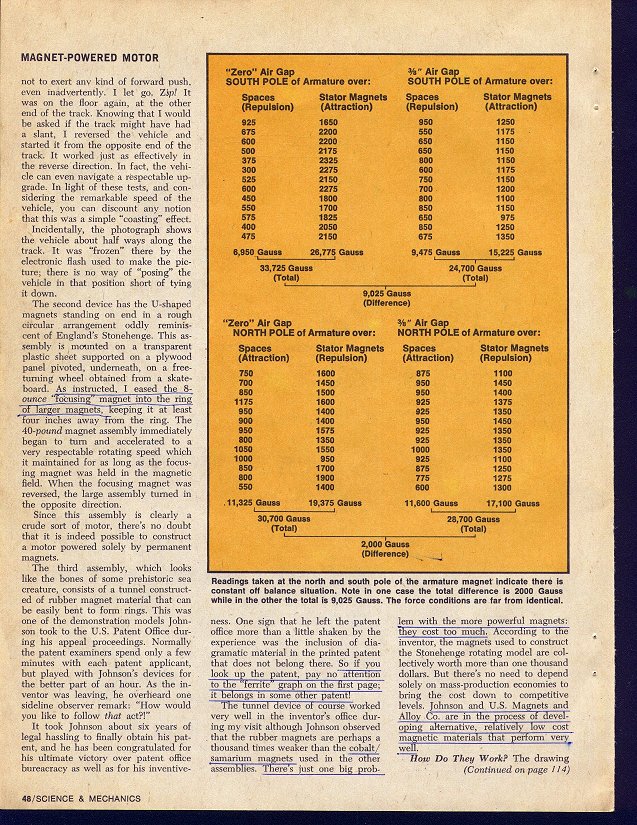
even inadvertently. I let go, Zip! It was on the floor again, at the other end of the track. Knowing that I would be asked if the track might have had a slant, I reversed the vehicle and started it from the opposite end of the track. It worked just as effectively in the reverse direction. In fact, the vehicle can even navigate a respectable upgrade. In light of these tests, and considering the remarkable speed of the vehicle, you can discount any notion that this was a simple “coasting” effect.
Incidentally, the photograph shows the vehicle about half ways along the track. It was “frozen” there by the electronic flash used to make the picture; there is no way of “posing” the vehicle in that position short of tying it down.
The second device has the U-shaped magnets standing on end in a rough circular arrangement oddly reminiscent of England’s Stonehenge. This assembly is mounted on a transparent plastic sheet supported on a plywood panel pivoted, underneath, on a free turning wheel obtained from a skateboard. As instructed, I eased the 8-ounce focusing magnet into the ring of larger magnets, keeping it at least four inches away from the ring. The 40 pound magnet assembly immediately began to turn and accelerated to a very respectable rotating speed which it maintained for as long as the focusing magnet was held in the magnetic field. When the focusing magnet was reversed, the large assembly turned in the opposite direction.
Since this assembly is clearly a crude sort of motor, there’s no doubt that it is indeed possible to construct a motor powered solely by permanent magnets.
The third assembly, which looks like the bones of some prehistoric sea creature, consists of a tunnel constructed of rubber magnet material that can be easily bent to form rings. This was one of the demonstration models Johnson took to the U.S. Patent Office during his appeal proceedings. Normally the patent examiners spend only a few minutes with each patent applicant, but played with Johnson’s devices for the better part of an hour. As the inventor was leaving, he overheard one sideline observer remark: “How would you like to follow that act?!”
It took Johnson about six years of legal hassling to finally obtain his patent, and he has been congratulated for his ultimate victory over patent office bureaucracy as well as for his inventiveness. One sign that he left the patent office more than a little shaken by the experience was the inclusion of diagrammatic material in the printed patent that does not belong there. So if you look up the patent, pay no attention to the “ferrite” graph on the first page; it belongs in some other patent!
The tunnel device of course worked very well in the inventor’s office during my visit although Johnson observed that the rubber magnets are perhaps a thousand times weaker than the cobalt samarium magnets used the other assemblies. There’s just one big problem with the more powerful magnets: they cost too much. According to the inventor, the magnets used to construct the Stonehenge rotating model are collectively worth more than one thousand dollars. But there’s no need to depend solely on mass-production economies to bring the cost down to competitive levels. Johnson and U.S. Magnets and Alloy Co. are in the process of developing alternative, relatively low cost magnetic materials that perform very well.
How do they work? The drawing

that shows a curved “arcuate” armature magnet in three successive positions over a line of fixed stator magnets provides at least highly simplified insights into the theory of permanent magnet motive power generation. Johnson says curved magnets with sharp leading and trailing edges are important because they focus and concentrate the magnetic energy much more effectively than do blunt-end magnets. These arcuate magnets are made slightly longer than the lengths of two stator magnets plus the intervening space, in Johnson’s setups about 3-1/8 inches long.
Note that the stator magnets all have their North faces upward, and that they are resting on a high magnetic permeability support plate that helps concentrate the force fields. The best gap between the end poles of the armature magnet and the stator magnets appears to be about 3/8 inch.
As the armature north pole passes over a magnet, it is repelled by the stator north pole; and there’s an attraction when the north pole is passing over a space between the stator magnets. The exact opposite is of course true with respect to the armature South pole. It is attracted when passing over a stator magnet, repelled when passing over a space.
The various magnetic forces that come into play are extremely complex, but the drawing shows some of the fundamental relationships. Solid lines represent attraction forces, dashed lines represent repulsion forces, and double lines in each case indicate the more dominant forces.
As the top drawing indicates, the leading (N) pole of the armature is repelled by the north poles of the two adjacent magnets. But, at the indicated position of the armature magnet, these two repulsive forces .(which obviously work against each other), are not identical; the stronger of the two forces (double dashed line) overpowers the other force and tends to move the armature to the left.
This left movement is enhanced by the attraction force between the armature north pole and the stator south pole at the bottom of the space between the stator magnets.
But that’s not all! Let’s see what is happening simultaneously at the other end (S) of the armature magnet. The length of this magnet (about 3-1/8 inches) is chosen, in relation to the pairs of stator in magnets plus the space between them, so that once again the attraction/repulsion forces work to move the armature magnet to the left. In this case the armature pole (S) is attracted by the north surfaces of the adjacent stator magnets but, because of the critical armature dimensioning, more strongly by the magnet (double solid line) that tends to “pull” the armature to the left. It overpowers the lesser “drag” effect of the stator magnet to the right. Here also there is the added advantage of, in this case, repulsion force between the south pole of the armature and the south pole in the space between the stator magnets.
The importance of correct dimensioning of the armature magnet cannot be over-emphasized. If it is either too long or too short, it could achieve an undesirable equilibrium condition that would stall movement. The objective is to optimize all force conditions to develop the greatest possible off-balance condition, but always’ in the same direction as the armature magnet moves along the row of stator magnets. However, if the armature is rotated 180 degrees and started at the opposite end of the track, it would behave in exactly the same manner except that it would, in this example, move from left to right. Also note that once the armature is in motion, it has momentum that helps carry it into the sphere of influence of the next pair of magnets where it gets another push and pull, and additional momentum.
Complex Forces
Some very complex magnetic forces are obviously at play in this deceptively simple magnetic system, and at this time it is impossible to develop a mathematical model of what actually occurs. However, computer analysis of the system, conducted by Professor William Harrison and his associates at Virginia Polytechnic Institute (Blacksburg, VA), provide vital feedback information that greatly helps in the effort to optimize these complex forces to achieve the most efficient possible operating design.
As Professor Harrison points out, in addition to the obvious interaction between the two poles of the armature magnet and the stator magnets, many other interactions are in play. The stator magnets affect each other and the support plate. Magnet distances and their strengths vary despite best efforts of manufacturers to exercise quality controls. In the assembly of the working model, there are inevitable differences between horizontal and vertical air spaces. All these interrelated factors must be optimized, which is why computer analysis in this refinement stage is vital. It’s a kind of information feedback system. As changes are made in the physical design, fast dynamic measurements are made to see whether the expected results have actually been achieved. The ‘new computer data is then used to develop new changes in the design of the experimental model. And so on, and on.
That very different magnetic conditions exist at the two ends of the armature is shown by the actual experimental data displayed in the table and associated graph. To obtain this information, the researchers first passed the probe of an instrument used to measure magnetic field strengths over the stator magnets and the intervening spaces. We shall call this the “Zero” level although there is a very tiny gap between the probe and the tops of the stator magnets. These measurements in effect indicate what each pole of the armature magnet “sees” below as it passes over. the stator magnets.
Next the probe is moved to a position just beneath one of the armature poles, at the top of the 3/8-inch armature-to-stator air gap. Another set of magnetic flux measurements is made. The procedure is repeated with the probe positioned just beneath the other armature pole.
Now “Instinct” might suggest, and correctly so, that the flux measurements at the top and bottom of the air gap will differ. But if “instinct” also suggests that these differences are pretty much the same at the two armature pole positions, you would be very much in error!
First study the two tables that show actual flux density measurements. Note that in this particular experiment the total magnetic flux amounted to 30,700 Gauss (the unit of magnetic strength) when the probe was held at the “Zero” level under the north pole of the magnet, and a total of 28,700 Gauss when the probe was moved to the top of the 3/8-inch air gap. The difference between these total ‘measurements is 2,000 Gauss.
Similar readings made at the air gap between the south pole of the armature and the stator magnets indicates a total flux at “Zero” level of 33,725 Gauss, and 24,700 Gauss at the top of the air gap. This time the difference is a much larger 9,025 Gauss, or four and one half times greater than for the north pole! Clearly, the magnetic force conditions are far from identical at the two ends of the armature magnet.
The middle five pairs of figures from each table hive been plotted in graphic form to make these differences more obvious. In the top “South Pole” graph the dashed line connects, the “Zero” level readings made over the stator magnets and over the intervening air spaces. Points along the solid line indicate comparable readings made with the probe just beneath the armature south pole. It is easy to see that there is an average 43% reduction of the attraction between the armature and stator magnets created by the air gap. Equally true, but perhaps not so obvious, is the fact that there is an average 36% increase of repulsion when the south pole of the armature passes over the spaces between the stator magnets. The percentage increase only seems smaller because it applies to a much smaller “Zero” level value.
The second graph shows that the changes are much less dramatic at the north pole of the armature. In this case there’s an average 11.7% decrease of attraction over the spaces, and a 2.4% increase, of repulsion when the armature north pole passes over the stator magnets.
As you study the data, be sure to note that the columns are labeled differently. In the case of the north pole data, the stator magnet areas repulse the armature north pole while the spaces between the stator magnets attract. The conditions are exactly the opposite for the south pole of the armature magnet. When the south pole passes over a magnet, there is strong attraction; when it passes over a space, there is repulsion.
The Ultimate Motor
A motor based on Johnson’s findings would be of extremely simple design compared to conventional motors. As shown in the diagrams developed from Johnson’s patent literature, the stator/base unit would contain a ring of spaced magnets backed by a high magnetic permeability sleeve. Three arcuate armature magnets would be mounted in the armature which has a belt groove for power transmission. The armature is supported on ball bearings on a shaft that either screws or slides into the stator unit. Speed control and start/stop action would be achieved by the simple means of moving the armature toward and away from the stator section.
There is a noticeable pulsing action in the simple prototype units that may be undesirable in a practical motor. The movement can be smoothed, the inventor believes, by simply using two or more staggered armature magnets as shown in another drawing.
What’s Ahead?
For inventor Howard Johnson and his permanent magnet power source there’s bound to be plenty of controversy, certainly, but also progress. A 5000 watt electric generator powered by a permanent magnet motor is already on the way, and Johnson has firm licensing agreements with at least four companies at this writing.
Will we see permanent magnet motors in automobiles in the near future? Johnson wants nothing to do with Detroit at this time because, as he puts it: “It’;s too emotional – we’d get smashed into the earth!” The inventor is equally reluctant to make predictions about other applications as well, mainly because he just wants time to perfect his ideas and, hopefully, get the scientific establishment to at least consider his unorthodox ideas with a more open mind.
For example, Johnson argues that the magnetic forces in a permanent magnet represent superconductance that is akin to phenomena normally associated only with extremely cold superconducting systems. He argues that a magnet is a room temperature superconducting system because the electron flow does not cease, and because this electron flow can be made to do work. And for those who pooh- pooh the idea that permanent magnets do work, Johnson has an answer: “You come along with a magnet and pick up a piece of iron, then some physicist says you didn’t do any work because you used that magnet. But you moved a mass through a distance. Right? That’s work that requires energy. Or you can hold one magnet in the air indefinitely by positioning it over another magnet with like poles facing. The physicist will argue that because it involves magnetic repulsion, no work is done. Yet if you support the same object with air, they will agree in a minute that work is done!”
There’s no doubt in Johnson’s mind that he has succeeded in extracting usable energy from the atoms of permanent magnets. But does that imply that the electron spins and associated phenomena that he thinks provide this power will eventually be used up? Johnson makes no pretense of knowing the answer: I didn’t start the electron spins, and I don’t know any way to stop them – do you? They may eventually stop, but that is not my problem.”
Johnson still has many practical problems to solve to perfect his invention. But his greater challenge may be to win general acceptance of his ideas by an obviously nervous scientific community in which many physicists remain compulsive about defending the law of Conservation of Energy without ever wondering whether that “law” really needs defending.
The dilemma facing Johnson is not really his dilemma but rather that of other scientists who have observed his prototypes. The devices obviously do work. But the textbooks say it shouldn’t work. And all that Johnson is really saying to the scientific community is this: here is a phenomenon which seems to contradict some of our traditional beliefs. For all our sakes let’s not dismiss it outright but take the time to understand the complex forces at work here.
All the patent drawings are shown above;
See the rest of the patent at
www.google.com/patents/US4151431
where I found the Science and Mechanics article and more:
www.rexresearch.com/johnson/1johnson.htm
more information also at:
http://peswiki.com/index.php/PowerPedia:Howard_Johnson
Tom Bearden’s Tips on Building the H.J. Motor
From: “Karl”, krlbrgmnn @ mailandnews.com
To: “Sterling D. Allan, PerenTech.com” sterlingda @ perentech.com
Sent: Thursday, December 19, 2002 2:01 PM
Subject: Truth about Howard Johnson and his motorSterling,
Just a quick note to let you know I spoke to Tom Bearden today and, regarding the statement on your webpage by your “anonymous source” who said “Howard Johnson never was able to get the rotary version to work. He was only able to get the linear version working, and there were some questions about its viability.”, Tom said such a person doesn’t know what they are talking about. I’d say Tom is in the best position to know, since he and Howard have been friends for decades and Howard has personally brought a functional, rotary PMM to Tom’s house, and they’ve played with it for hours. Next to Howard himself, I’d consider Tom to be the best resource on the subject of HJ’s PMM.
He also said that Howard is still working on getting another functioning unit constructed (he’s had numerous setbacks over the years after his working unit was vandalized by thieves that broke into Howard’s shop and stole only the magnets off that model, leaving many $K worth of other material nearby untouched). Howard is still plugging away every day, at over 70 years old, but his wife’s health problems are keeping him busy. However, he has gotten hooked up with a respectable, honest businessman who is financing him and Howard also now has some younger help to do the grunt work that is becoming tougher for him. All in all, Tom hopes to see some real progress being made for Howard in the next year or so.
Tom mentioned that there are a few critical things that anyone who wants to successfully build a working HJ PMM needs to know, some of which are probably obvious to the more experienced builders:
1) The most critical element is the precise machining of the magnets. Joe Q. Public, with his diamond saw, cutting his own magnets by hand has little chance of succeeding in shaping the magnets to the aerospace-critical specs that are the minimum necessary, much less duplicating that feat several times for each necessary part.
2) Alignment of the parts is highly important too. One slight misalignment and the motor will not run continuously.
3) All magnets aren’t the same. This application requires expensive, extremely high quality magnets. Howard, in order to get them cheaper, was buying them in $50K lots from China, where high quality and a lower price can be had.
I also spoke with a gentleman named Gary Hanson who had been in touch with Howard years ago when Gary was trying to build Howard’s motor. Howard told him, as I think most researchers on this know now, that the motor *can* be build directly from the patent but that there needs to be 5 or 6 armtures and not just the one that is shown as an illustration in the patent. Just want to make sure any newbies understand this.
I hope some of this has helped clear up any misunderstandings for those of us interested in building a functional HJ PMM. My opinion is that, if you want to do it right, go to the horse’s mouth (Howard) or else as close as you can possibly get (Tom). Hopefully, doing so will enable us to make this motor a reality.
Regards, Karl
from http://freeenergynews.com/Directory/Howard_Johnson_Motor/How2/Bearden_tips.htm
more information on the H.J. magnet motor – several builders
List of several magnet motors – and a few others at
http://www.FreeEnergyNews.com/Directory/MagneticMotors/
a case of repeated suppression !
“Howard is still working on getting another functioning unit constructed (he’s had numerous setbacks over the years after his working unit was vandalized by thieves that broke into Howard’s shop and stole only the magnets off that model, leaving many $K worth of other material nearby untouched).”
Here we have a well documented case of a man who succeeded in building a permanent magnet motor.
It is disappointing that the magnets are so difficult to shape (?) correctly that even he could not create a second set.
-ed
Biography:
Howard Robert Johnson was born in 1919 in Pound, Virginia, USA, and died Jan. 2, 2008 in Blacksburg, VA. He is the researcher and inventor of an all magnet motor, which modern physics deigns impossible. The device generates motion, either rotary or linear, from nothing but permanent magnets in rotor as well as stator, acting against each other. In his invention (called a “Permanent Magnet Motor”), a permanent magnet armature is magnetically propelled along a guided path by interaction with the field within a flux zone limited on either side of the path by an arrangement of permanent stator magnets.The unofficial “father of spintronics,” pioneer researcher Howard Johnson began investigating magnetism in 1942 as a graduate student at Vanderbilt University, studying Bohr’s work on the electron.
The permanent magnet motor was conceived by Howard Johnson sometime after the 1940s.
He received U.S. Patent 4151431 (G.patent; PDF) on April 24, 1979. The United States Patent office main classification of his 4151431 patent is as a “electrical generator or motor structure, dynamoelectric, linear”.
from http://peswiki.com/index.php/Howard_Johnson
Alfred Hubbard’s Generator
Tesla’s Electric Car
Tesla, Radiant Energy, page 1
Tesla’s Biography
Tesla’s Unk. Manuscript
Car gets 400+ MPG John Weston
Run Your Car On Vapors






If his magnet motor really works permanently and with no required push of a hand, that would be really mind blowing,no need to put in oil,gas ,no water, and it will also proof that it is not only possible to create energy from 0 ,but you can even multiply it ,so if this magnet motor could only generate 12 volt,no problem because an added transformer could convert that 12 volt into 220 ,
Not only can you get free and indefinitive energy that way but you can do now everything for free, such as driving car,flying in the air with a jetpack, cooking water,warming up your house,cooling your car from the inside,,or how about setting up a company and run all your machines and light bulbs for free, how about setting up a charging station for cars in wich people once paid could charge their electric car , so this way you will not only be able to get righ for free but you can also pay yourself back and get rid off all the bills you had,
I really can’t wait to see one in action because this could shove away all those magnet motor scammers from youtube😊
I’d like to see any videos that he actually made and is there a museum where we can see his work?
Good site but like Steven Mccune, I also see no images using chrome or Microsoft Edge.
what pcs, laptops, phones, have you tried?
I am very inspired by Mr. Johnsons patents, but unfortunately I don’t think your web page is working very well. I cant see any images or diagrams. In your best interest with these patents and my own personal work could you update your website so it works as well as the patents? Please and thanks
Sorry you are having trouble with the images. We have desktops, laptops, and phones which use firefox and chrome and etc. and have no problem with images on this page or any other. … maybe if you try a different browser or phone, …?
I’ll be very interested to know more about the Howard Johnson Amazing new motor powered only by permanent Magnets 15 hp output drive 5000 watt home generator.
have you ever made this motor into a base engine of a car it would be very practical and possibly get rid off all use of gasoline run cars if you made this into a vehicle you could save our race from killing them selves off. i beg of you to make this invention more then some old files i need you to go big and never go home.
Hi Brandon C Forsyth:
If you are interested in having your product marketed and it works to what you believe will benefit humanity, please email me at korstrategies at gmail.com My name is John so please email and we can start the discussion. Thank you.
i also have a permanent magnetic motor. the design uses almost the entire motor weight to generate torque and momentum. the axis of rotation is static and there is no way around that. I need someone to promote my invention. I to have been laughed at even after a working model. I would split 50/50 and you could get recognition don’t care
Also found a way focus circular energy directional without a transmission to the wheels when talking about a wheeled vehicle, in a plane after a lot of refinement there would be no need for a truster or prop or jet propulsion but this technology in avionics is in infancy in my production
If you built a working model, … and it powered a generator, there should be no reason to laugh.
totally by magnets alone
My nedd for whoe seller i am oaliullah form in bangladesh my mobile numbare +8801832787147 call me give me your mobile numbare
If you read this page, you will know that no one has been able to re-create H.J.’s motor.
howard johnson, we are with you all the way! !!!! don’t let anyone or anything stop you! !!!!!!!!!!!!!!!!!!!
He would thank you for your support, but he died Jan. 2nd, 2008 (see above)